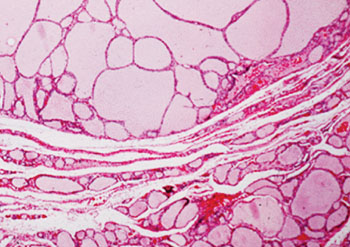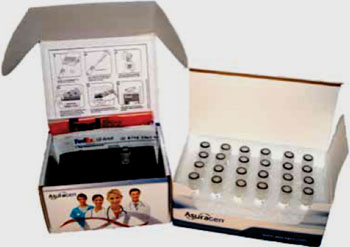Genetic Mutation Test Improves Definitive Diagnosis of Thyroid Nodules
|
By LabMedica International staff writers Posted on 03 Jun 2015 |

Image: Histopathology of thyroid colloid nodules displaying macrofollicles lined by flattened thyroid epithelial cells. The nodules are circumscribed and do not have a fibrous capsule (Photo courtesy of the University of Siena).

Image: The miRInform Thyroid test collection kit for the molecular diagnosis of thyroid cancer (Photo courtesy of Asuragen Inc.).
Cytopathology on ultrasound-guided fine needle aspiration biopsies has dramatically improved the clinical management of patients with solid thyroid nodules that are greater than one centimeter.
Molecular testing for oncogenic mutations or gene expression in fine-needle aspirations (FNA) from thyroid nodules with indeterminate cytology identified a subset of benign or malignant lesions with high predictive value.
Several scientists working at various institutions including Jersey Shore University Medical Center (Neptune City, NJ, USA) evaluated a novel diagnostic algorithm combining mutation detection and micro-ribonucleic acid (miRNA) expression to improve the diagnostic yield of molecular cytology. The teams tested 638 surgical specimens and preoperative FNAs for 17 validated gene alterations using a commercial thyroid test and with a 10-miRNA gene expression classifier generating positive (malignant) or negative (benign) results. Qualitative molecular results were compared to surgical histopathology to determine diagnostic performance and model clinical impact.
The miRInform Thyroid test (Asuragen Inc.; Austin, TX, USA) detected mutations in 69% of nodules with malignant outcome. Among mutation-negative specimens, miRNA testing correctly identified 64% of malignant cases and 98% of benign cases. The diagnostic sensitivity and specificity of the combined algorithm was 89% and 85%, respectively. At 32% cancer prevalence, 61% of the molecular results were benign with a negative predictive value of 94%. Independently of variations in cancer prevalence, the test increased the yield of true benign results by 65% relative to messenger (mRNA)-based gene expression classification and decreased the rate of avoidable diagnostic surgeries by 69%.
The authors including those from Asuragen, Inc., concluded that multiplatform testing for DNA, mRNA and miRNA can accurately classify benign and malignant thyroid nodules, increase the diagnostic yield of molecular cytology, and further improve the preoperative risk-based management of benign nodules. The study was published on May 12, 2015, in the Journal of Clinical Endocrinology & Metabolism.
Related Links:
Jersey Shore University Medical Center
Asuragen Inc.
Molecular testing for oncogenic mutations or gene expression in fine-needle aspirations (FNA) from thyroid nodules with indeterminate cytology identified a subset of benign or malignant lesions with high predictive value.
Several scientists working at various institutions including Jersey Shore University Medical Center (Neptune City, NJ, USA) evaluated a novel diagnostic algorithm combining mutation detection and micro-ribonucleic acid (miRNA) expression to improve the diagnostic yield of molecular cytology. The teams tested 638 surgical specimens and preoperative FNAs for 17 validated gene alterations using a commercial thyroid test and with a 10-miRNA gene expression classifier generating positive (malignant) or negative (benign) results. Qualitative molecular results were compared to surgical histopathology to determine diagnostic performance and model clinical impact.
The miRInform Thyroid test (Asuragen Inc.; Austin, TX, USA) detected mutations in 69% of nodules with malignant outcome. Among mutation-negative specimens, miRNA testing correctly identified 64% of malignant cases and 98% of benign cases. The diagnostic sensitivity and specificity of the combined algorithm was 89% and 85%, respectively. At 32% cancer prevalence, 61% of the molecular results were benign with a negative predictive value of 94%. Independently of variations in cancer prevalence, the test increased the yield of true benign results by 65% relative to messenger (mRNA)-based gene expression classification and decreased the rate of avoidable diagnostic surgeries by 69%.
The authors including those from Asuragen, Inc., concluded that multiplatform testing for DNA, mRNA and miRNA can accurately classify benign and malignant thyroid nodules, increase the diagnostic yield of molecular cytology, and further improve the preoperative risk-based management of benign nodules. The study was published on May 12, 2015, in the Journal of Clinical Endocrinology & Metabolism.
Related Links:
Jersey Shore University Medical Center
Asuragen Inc.
Latest Molecular Diagnostics News
- Blood Test Could Predict Relapse of Autoimmune Blood Vessel Disease
- First-of-its-Kind Blood Test Detects Trauma-Related Diseases
- Key Gene Identified in Common Heart Disease Unlocks Life-Saving Diagnostic Potential
- Cheap Cell-Free DNA Based Test Accurately Predicts Preterm Birth
- RNA Blood Test Detects Cancers and Resistance to Treatment
- IL-6 Outperforms Traditional Tests for Early Sepsis Detection
- Simple Blood Test Improves Heart Attack and Stroke Risk Prediction
- Blood Biomarker Test Could Detect Genetic Predisposition to Alzheimer’s
- Novel Autoantibody Against DAGLA Discovered in Cerebellitis
- Blood Test Could Identify Patients at Risk for Severe Scleroderma
- Gene-Based Blood Test Accurately Predicts Tumor Recurrence of Advanced Skin Cancer
- Rapid Blood Test Identifies Pre-Symptomatic Patients with Parkinson’s Disease
- Blood Test for Early Alzheimer's Detection Achieves Over 90% Accuracy
- RNA-Based Blood Test Detects Preeclampsia Risk Months Before Symptoms
- First Of Its Kind Test Uses microRNAs to Predict Toxicity from Cancer Therapy
- Novel Cell-Based Assay Provides Sensitive and Specific Autoantibody Detection in Demyelination
Channels
Clinical Chemistry
view channel
‘Brilliantly Luminous’ Nanoscale Chemical Tool to Improve Disease Detection
Thousands of commercially available glowing molecules known as fluorophores are commonly used in medical imaging, disease detection, biomarker tagging, and chemical analysis. They are also integral in... Read more
Low-Cost Portable Screening Test to Transform Kidney Disease Detection
Millions of individuals suffer from kidney disease, which often remains undiagnosed until it has reached a critical stage. This silent epidemic not only diminishes the quality of life for those affected... Read more
New Method Uses Pulsed Infrared Light to Find Cancer's 'Fingerprints' In Blood Plasma
Cancer diagnoses have traditionally relied on invasive or time-consuming procedures like tissue biopsies. Now, new research published in ACS Central Science introduces a method that utilizes pulsed infrared... Read moreHematology
view channel
New Scoring System Predicts Risk of Developing Cancer from Common Blood Disorder
Clonal cytopenia of undetermined significance (CCUS) is a blood disorder commonly found in older adults, characterized by mutations in blood cells and a low blood count, but without any obvious cause or... Read more
Non-Invasive Prenatal Test for Fetal RhD Status Demonstrates 100% Accuracy
In the United States, approximately 15% of pregnant individuals are RhD-negative. However, in about 40% of these cases, the fetus is also RhD-negative, making the administration of RhoGAM unnecessary.... Read moreImmunology
view channel
Stem Cell Test Predicts Treatment Outcome for Patients with Platinum-Resistant Ovarian Cancer
Epithelial ovarian cancer frequently responds to chemotherapy initially, but eventually, the tumor develops resistance to the therapy, leading to regrowth. This resistance is partially due to the activation... Read more
Machine Learning-Enabled Blood Test Predicts Immunotherapy Response in Lymphoma Patients
Chimeric antigen receptor (CAR) T-cell therapy has emerged as one of the most promising recent developments in the treatment of blood cancers. However, over half of non-Hodgkin lymphoma (NHL) patients... Read moreMicrobiology
view channel
Handheld Device Delivers Low-Cost TB Results in Less Than One Hour
Tuberculosis (TB) remains the deadliest infectious disease globally, affecting an estimated 10 million people annually. In 2021, about 4.2 million TB cases went undiagnosed or unreported, mainly due to... Read more
New AI-Based Method Improves Diagnosis of Drug-Resistant Infections
Drug-resistant infections, particularly those caused by deadly bacteria like tuberculosis and staphylococcus, are rapidly emerging as a global health emergency. These infections are more difficult to treat,... Read more
Breakthrough Diagnostic Technology Identifies Bacterial Infections with Almost 100% Accuracy within Three Hours
Rapid and precise identification of pathogenic microbes in patient samples is essential for the effective treatment of acute infectious diseases, such as sepsis. The fluorescence in situ hybridization... Read morePathology
view channel
Sensitive and Specific DUB Enzyme Assay Kits Require Minimal Setup Without Substrate Preparation
Ubiquitination and deubiquitination are two important physiological processes in the ubiquitin-proteasome system, responsible for protein degradation in cells. Deubiquitinating (DUB) enzymes contain around... Read more
World’s First AI Model for Thyroid Cancer Diagnosis Achieves Over 90% Accuracy
Thyroid cancer is one of the most common cancers worldwide, and its precise management typically relies on two primary systems: (1) the 8th edition of the American Joint Committee on Cancer (AJCC) or ... Read more
Breakthrough Diagnostic Approach to Significantly Improve TB Detection
Tuberculosis (TB) remains the deadliest infectious disease globally, with 10.8 million new cases and 1.25 million deaths reported in 2023. Early detection through effective screening is crucial in identifying... Read more
Rapid, Ultra-Sensitive, PCR-Free Detection Method Makes Genetic Analysis More Accessible
Genetic testing has been an important method for detecting infectious diseases, diagnosing early-stage cancer, ensuring food safety, and analyzing environmental DNA. For a long time, polymerase chain reaction... Read moreTechnology
view channel
Disposable Microchip Technology Could Selectively Detect HIV in Whole Blood Samples
As of the end of 2023, approximately 40 million people globally were living with HIV, and around 630,000 individuals died from AIDS-related illnesses that same year. Despite a substantial decline in deaths... Read more
Pain-On-A-Chip Microfluidic Device Determines Types of Chronic Pain from Blood Samples
Chronic pain is a widespread condition that remains difficult to manage, and existing clinical methods for its treatment rely largely on self-reporting, which can be subjective and especially problematic... Read more
Innovative, Label-Free Ratiometric Fluorosensor Enables More Sensitive Viral RNA Detection
Viruses present a major global health risk, as demonstrated by recent pandemics, making early detection and identification essential for preventing new outbreaks. While traditional detection methods are... Read moreIndustry
view channel
Cepheid and Oxford Nanopore Technologies Partner on Advancing Automated Sequencing-Based Solutions
Cepheid (Sunnyvale, CA, USA), a leading molecular diagnostics company, and Oxford Nanopore Technologies (Oxford, UK), the company behind a new generation of sequencing-based molecular analysis technologies,... Read more
Grifols and Tecan’s IBL Collaborate on Advanced Biomarker Panels
Grifols (Barcelona, Spain), one of the world’s leading producers of plasma-derived medicines and innovative diagnostic solutions, is expanding its offer in clinical diagnostics through a strategic partnership... Read more



















